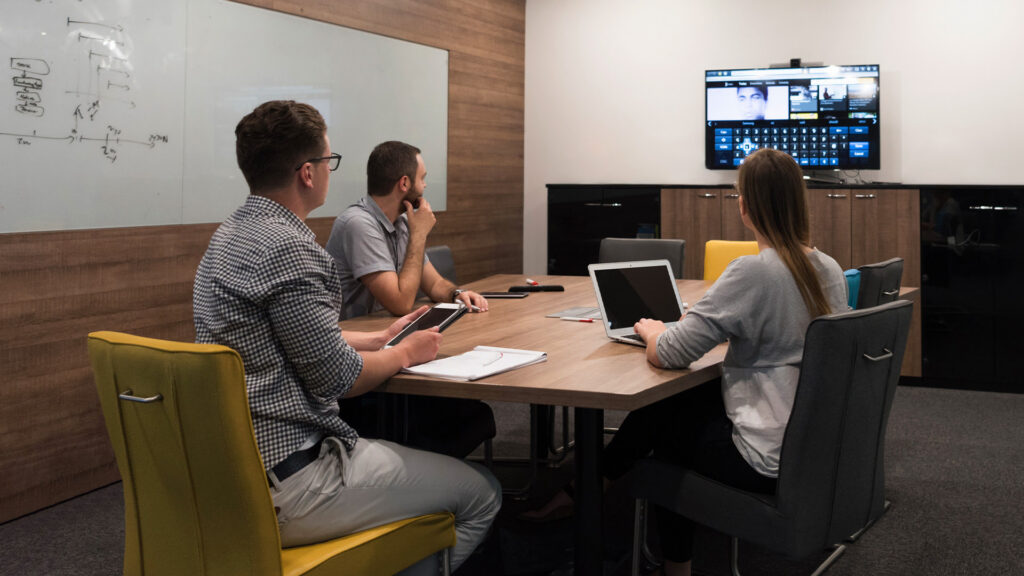 I was struck by just how powerful a virtual meeting room (VMR) had become for me when I was in the office with two co-workers and we wanted to connect with someone in our Montreal office for a discussion.
I was struck by just how powerful a virtual meeting room (VMR) had become for me when I was in the office with two co-workers and we wanted to connect with someone in our Montreal office for a discussion.
Instead of looking for an open meeting room and using technology to connect our colleague in Montreal into the room, we all went back to our desks and called into a video VMR. Not because there wasn’t a room available, but because it would be a better experience for everyone. We could:
- See each other better
- Hear each other better and;
- Each share the content on our computers with each other easily
I have heard similar stories from other companies as well. Sitting at their desks people can join virtual meeting rooms instead of going into real meeting rooms – even when they are on the same office floor.
On the surface this may not seem very significant, but the impact of the increased use of VMRs in your company can be dramatic.
Lets take a step back first and review the four types of meetings that can be enabled using real-time collaborative communications tools:
- A Meeting Room connected to another Meeting Room(s)
- A Meeting Room with Remote Participants connected into it
- Person to Person connections
- Virtual Meeting Rooms (VMRs)
While the first three types of meetings are probably familiar to everyone, VMRs might not be, so let me explain.
A VMR is a room in the cloud. It replaces the requirement for a physical meeting room and it only exists temporarily when technology creates a connection between people. Participants call into a technical address with a simple name like “Paul’s Room”. When they call into Paul’s Room, the images from the cameras on their PC are combined into a single image shared by all the participants. So if there are 4 participants in the VMR the image will look like this.
In a VMR everyone can see each other clearly. There is no “Boardroom Bowling Alley” view of the people in the room where participants are so far away from the camera that you can’t really see their faces. You can hear each other well, assuming your PC audio is set up properly, and it is easy for people to share content with each other right from the computer they are using to make the call.
Everything you need for a VMR call is right there on your PC or Mac. And you can make the call from anywhere as long as you have your PC and it is connected to the Internet. A broadband, quality Internet connection is pretty standard and a lack of this type of connection is really the only thing that can prevent people from participating fully in a rich collaborative VMR experience. A virtual meeting that has video as part of it eliminates a lot of the shortcomings a virtual “audio only” call has, as explained here in this blog.
VMRs – better than being in a real meeting?
I often prefer to have a virtual meeting instead of an in person meeting.
This may seem odd, but there are some real advantages to virtual meetings that just make it easier to collaborate and it delivers a better experience for everyone. Here are some of the advantages for the meeting participants of using a VMR to conduct a meeting:
- You can hold the meeting anytime, as long as everyone is available for the meeting. There is no need to look for an available meeting room. Everyone can connect from their desks, their homes, on the road, wherever they are.
- Everyone can share the content on his or her PC or Mac computer.* The meeting is not limited to the content of whoever is connected to the room system. These problems with content sharing in a room are being eliminated with some of the new in-room content sharing technologies which I covered in this blog.
- Each participant can manipulate their own view of the content being shared, e.g. they can make it bigger and more legible to suit their needs
- Each person can focus on the people in the room or the content being shared as it suits them. Just like in a live meeting.
- There tends to be less distraction in the meeting because everyone is using their technology to participate in the meeting, versus doing other things on their technology in a live meeting.
*Some collaborative communications tools allow multiple participant sharing, others do not.
VMRs can drive a very good business case
Not only can VMRs become a preferred way to conduct some meetings, but there are also some very good economic reasons for using them.
- Savings on real estate: The more your organization uses VMRs the less the requirement for physical meeting rooms. Real Estate costs are still one of the most expensive costs for organizations. See this blog for more on how People-Place-Technology are coming together. And meeting rooms are still scarce in most organizations. Enabling everyone in the organization with his or her own virtual room will drastically cut down on the demand for physical meeting space in the office.
- Enable more meetings: Because people can enable a meeting on demand from wherever they are, you can make your workers more productive. The VMR eliminates the constraint of requiring a meeting room to be available in order to conduct a meeting. In addition, the time it takes to find and book a meeting room is eliminated.
- Speeds up execution: Saving cost on meeting rooms is an operational savings, but even more dramatic returns are realized as an organization moves to greater collaborative optimization. Eliminating constraints to workflow will speed up the execution within your organization. The organization will be collaborating better, which means the organization will perform better than its peers. And organizations that collaborate better outperform their peers by 2 to 6 times.
Personal technology required
To be able to use a VMR your personal technology accessories needs to be easy to use and provide a quality, consistent experience. You need:
- A good unified communications and collaboration (UC&C) tool set, like Jabber or Skype for business; or good Meeting facilitation software like WebEx
- Good audio quality
- A second screen display screen for content viewing
- A camera on your PC that provides a good image of you and proper lighting
I talk about these in a bit more detail in the second part of this blog but I will write a separate blog on personal technology accessories for better communication in the future.
You should get started using VMRs for more of your meetings. They can be a very powerful collaborative enabler for your organization. The easiest way to get started is to buy the capability through a cloud service provider (click here for a blog about Video in the Cloud), or by signing up for your own WebEx account.
If you have a story about using VMRs, we would love to hear it. Please share it in the comment section below. If you want to learn more about creative technology solutions contact us to learn more about our HybridX solutions.







